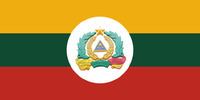Active 1989 (1989)–present Strength 3,000–4,000 | Ideology Shan nationalism | |
 | ||
Leaders Sai LeunSao HsenglaSan Pae Battles and wars Internal conflict in Myanmar Allies Myanmar National Democratic Alliance Army, United Wa State Army, New Democratic Army - Kachin Areas of operations Mong La Township, Shan State | ||
The National Democratic Alliance Army (Burmese: မြန်မာအမျိုးသား ဒီမိုကရက်တစ် မဟာမိတ်တပ်မတော်; abbreviated NDAA), also known as the National Democratic Alliance Army-Eastern Shan State (NDAA-ESS), the Eastern Shan State Army) and the Mongla Army, is an insurgent group in eastern Shan State, Myanmar (Burma). The latter name originated from its location in the Mong La Township in eastern Shan State, known also as 'Shan State Special region 4'.
History
The Mongla area had been under the control of several warlords since the 1960s. The NDAA was formed in 1989 after splitting from the former Communist Party of Burma (CPB). The strength of the army is 3,000 to 4,000 men.
The NDAA was one of the first groups to sign a ceasefire with the Tatmadaw (Myanmar Armed Forces). After the ceasefire, the area underwent an economic boom, with both the NDAA and local Tatmadaw units benefiting financially from increased opium harvests and narcotics trafficking. The NDAA declared an opium ban in the Mongla region in 1997 and signed a new ceasefire with the Burmese government in 2011.
The NDAA maintains close ties with other rebel armed groups that split from the CPB, such as the Myanmar Nationalities Democratic Alliance Army (MNDAA), the New Democratic Army - Kachin (NDA-K), and the United Wa State Army (UWSA). In 2008 the UWSA was strongly against giving away the area of Mong Pawk from its control because it serves as a link with its ally, the National Democratic Alliance Army in Mongla.
